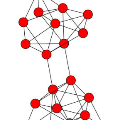Recent years have witnessed the tremendous research interests in network embedding. Extant works have taken the neighborhood formation as the critical information to reveal the inherent dynamics of network structures, and suggested encoding temporal edge formation sequences to capture the historical influences of neighbors. In this paper, however, we argue that the edge formation can be attributed to a variety of driving factors including the temporal influence, which is better referred to as multiple aspects. As a matter of fact, different node aspects can drive the formation of distinctive neighbors, giving birth to the multi-aspect embedding that relates to but goes beyond a temporal scope. Along this vein, we propose a Mixture of Hawkes-based Temporal Network Embeddings (MHNE) model to capture the aspect-driven neighborhood formation of networks. In MHNE, we encode the multi-aspect embeddings into the mixture of Hawkes processes to gain the advantages in modeling the excitation effects and the latent aspects. Specifically, a graph attention mechanism is used to assign different weights to account for the excitation effects of history events, while a Gumbel-Softmax is plugged in to derive the distribution over the aspects. Extensive experiments on 8 different temporal networks have demonstrated the great performance of the multi-aspect embeddings obtained by MHNE in comparison with the state-of-the-art methods.
翻译:最近几年里,人们对网络嵌入产生了巨大的研究兴趣。 外部工程将邻里结构作为关键信息,揭示了网络结构的内在动态,并提出了编码时间边缘形成序列以捕捉邻居的历史影响。 但是,在本论文中,我们争辩说,边缘形成可归因于各种驱动因素,包括时间影响,这更被称之为多个方面。事实上,不同的节点可以推动形成独特的邻居,产生与历史事件相关但超越时间范围的多层嵌入。我们为此提议了一个基于霍克斯的时空网络嵌入(MHNE)混合模型,以捕捉网络的侧面驱动邻里形成。在MHNE中,我们把多层嵌入霍克斯进程混在一起的多种驱动因素编码起来,以便在模拟引力效应和潜伏方面获得优势。 具体地说,一个图形关注机制可以分配不同重量来计算历史事件的引力效应。 在 Gumbel-Softmax 上, 一个基于霍克斯网络嵌入的混合模型中,通过不同层次的模型将MHE的模型插入了MH 。





